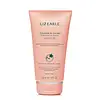What's inside
What's inside
 Key Ingredients
Key Ingredients

No key ingredients
 Benefits
Benefits

 Concerns
Concerns

 Ingredients Side-by-side
Ingredients Side-by-side

Caprylic/Capric Triglyceride
MaskingGlycerin
HumectantWater
Skin ConditioningSafflower Seed Oil Polyglyceryl-4 Esters
CleansingSucrose Stearate
EmollientSucrose Laurate
EmollientSambucus Nigra Seed Oil
Butyrospermum Parkii Oil
EmollientPrunus Amygdalus Dulcis Oil
Skin ConditioningMalpighia Glabra Fruit Juice
Skin ConditioningTocopherol
AntioxidantZymomonas Ferment Extract
HumectantMel
EmollientMaltodextrin
AbsorbentLimonene
PerfumingLinalool
PerfumingGeraniol
PerfumingCitral
PerfumingCitronellol
PerfumingParfum
MaskingCaprylic/Capric Triglyceride, Glycerin, Water, Safflower Seed Oil Polyglyceryl-4 Esters, Sucrose Stearate, Sucrose Laurate, Sambucus Nigra Seed Oil, Butyrospermum Parkii Oil, Prunus Amygdalus Dulcis Oil, Malpighia Glabra Fruit Juice, Tocopherol, Zymomonas Ferment Extract, Mel, Maltodextrin, Limonene, Linalool, Geraniol, Citral, Citronellol, Parfum
Water
Skin ConditioningHamamelis Virginiana Water
AstringentPEG-60 Almond Glycerides
EmulsifyingGlycerin
HumectantDecyl Glucoside
CleansingCentaurea Cyanus Flower Extract
AstringentEuphrasia Officinalis Extract
AntimicrobialAloe Barbadensis Leaf Juice
Skin ConditioningPhenoxyethanol
PreservativePanthenol
Skin ConditioningBenzoic Acid
MaskingDehydroacetic Acid
PreservativeEthylhexylglycerin
Skin ConditioningSodium Hydroxide
BufferingCitric Acid
BufferingSodium Benzoate
MaskingPotassium Sorbate
PreservativeWater, Hamamelis Virginiana Water, PEG-60 Almond Glycerides, Glycerin, Decyl Glucoside, Centaurea Cyanus Flower Extract, Euphrasia Officinalis Extract, Aloe Barbadensis Leaf Juice, Phenoxyethanol, Panthenol, Benzoic Acid, Dehydroacetic Acid, Ethylhexylglycerin, Sodium Hydroxide, Citric Acid, Sodium Benzoate, Potassium Sorbate
Ingredients Explained
These ingredients are found in both products.
Ingredients higher up in an ingredient list are typically present in a larger amount.
Glycerin is already naturally found in your skin. It helps moisturize and protect your skin.
A study from 2016 found glycerin to be more effective as a humectant than AHAs and hyaluronic acid.
As a humectant, it helps the skin stay hydrated by pulling moisture to your skin. The low molecular weight of glycerin allows it to pull moisture into the deeper layers of your skin.
Hydrated skin improves your skin barrier; Your skin barrier helps protect against irritants and bacteria.
Glycerin has also been found to have antimicrobial and antiviral properties. Due to these properties, glycerin is often used in wound and burn treatments.
In cosmetics, glycerin is usually derived from plants such as soybean or palm. However, it can also be sourced from animals, such as tallow or animal fat.
This ingredient is organic, colorless, odorless, and non-toxic.
Glycerin is the name for this ingredient in American English. British English uses Glycerol/Glycerine.
Learn more about GlycerinWater. It's the most common cosmetic ingredient of all. You'll usually see it at the top of ingredient lists, meaning that it makes up the largest part of the product.
So why is it so popular? Water most often acts as a solvent - this means that it helps dissolve other ingredients into the formulation.
You'll also recognize water as that liquid we all need to stay alive. If you see this, drink a glass of water. Stay hydrated!
Learn more about Water